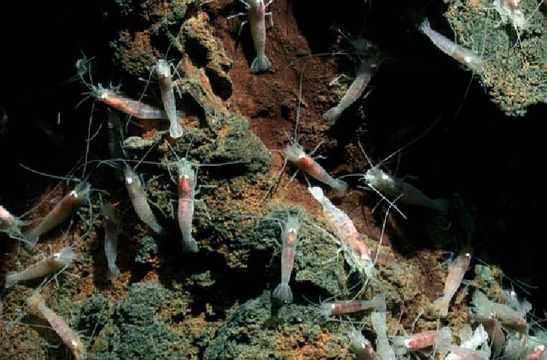
| Palaeos |  |
Decapoda |
| Arthropoda | Caridea |
| Page Back | Unit Up: Arthropoda | Unit Home | Clade Up: Eucarida | Page Next |
| Unit Back: Malacostraca | Clade Down: None | Dendrogram | References | Unit Next: Hexapoda |
|
Abbreviated Dendrogram
MALACOSTRACA | `--DECAPODA |--Dendrobranchiata `--Pleocyemata |--Caridea `--Reptantia |--Eryonoidea `--Eureptantia |--Astacidea |--Palinuroidea `--+--Anomura `--Brachyura |
Contents
Overview |
Taxa on This Page
 A number of individuals of Nautilocaris saintlaurentae Komai & Segonzac (Decapoda: Caridea: Bresilioidea: Alvinocarididae) on the sulphide wall of a hydrothermal vent, North Fiji Basin, at a depth of 2,000 meters. Distinct species and genera of Alvinocaridids are found clustered around different hypdrotherma;l vents, and illustrate the great dicersity and adaptability of the malacostraca. Among the most abundant arthropods in the sea, Malacostracans are found everywhere from the littoral zone to the pelagic water column to the bottom of the ocean, and, in the other direction, freshwater and even dry land. Photographer: T. Komai, Publisher Chris Allen, via Encyclopedia of Life, Creative Commons Non-Commercial Attribution. |
The Caridea are one of the main groups of true shrimps. They were previously included under the Natantia, but as that is a paraphyletic assemblagfe the term is no longer used. Of the two main shrimp groups, the Caridea are considered to be closer to the crabs and lobsters (Reptantia) than the Dendrobranchiata (sometyimes called prawns, although generally terms like "prawns" and "shimps" are confused). MAK120530
The fossil record is sparse, with only 57 fossil species known. The earliest of these cannot be assigned to any family, but date from the Early Jurassic and Cretaceous - Wikipedia. In the Solnhofen numerous genera occur, some of which, such as Udora Munster, and Udorella Oppel have exopodites on the thoracic legs, a primitive character suggesting affinity with the Recent family Acanthephyridae. Other Solnhofen genera, in which these exopodites appear to be wanting, are Blaculla,Hefriga and Elder Miinster. The Recent deep-sea genus Oplophorus Milne Edwards (Acanthephyridae) has been identified in the Upper Cretaceous of Westphalia. Some Caridea are found in frosh-water Tertiary deposits, as for example Homelys von Meyer, from the Miocene of Oeningen; but it is impossible to say what relation they bear to recent fresh-water Caridea - Zittel & Eastman 1913 (public domain) - needs revision
Dendrogram, from Christopher Taylor - Variety of LIfe.
Caridea
| i. s.: Acanthephyra M85 [Oplophoridae, Oplophoroidea MD01]
| Galatheacaris [Galatheacarididae, Galatheacaridoidea] MD01
| Bresilioidea MD01
| |--Agostocarididae MD01
| |--Alvinocarididae MD01
| |--Bresiliidae MD01
| |--Disciadidae MD01
| `--Mirocaris fortunata (Martin & Christiansen 1995) [Mirocarididae] [=Chorocaris fortunata] MD01
| Campylonotoidea MD01
| |--Bathypalaemonella [Bathypalaemonellidae] MD01
| `--Campylonotidae MD01
| Pasiphaea B26 [Pasiphaeidae MD01, Pasiphaeoidea MD01]
| Atyidae MD01
| Nematocarcinoidea MD01
| |--Eugonatonotidae MD01
| |--Lipkius C85 [Rhynchocinetidae MD01]
| |--Nematocarcinus M85 [Nematocarcinidae MD01]
| `--Xiphocaris H86 [Xiphocarididae MD01]
| Psalidopodidae [Psalidopodoidea] MD01
| Stylodactylidae [Stylodactyloidea] MD01
| Physetocarididae [Physetocaridoidea] MD01
| Lebbeus polaris (Sabine 1824) FZA07
| Processidae [Processoidea] MD01
| |--Ambidexter symmetricus M85
| `--Processa M85
|--+--Procaris Chace & Manning 1972 DAS03, H86 [Procarididae, Procaridoidea]
| `--+--Alpheoidea DAS03
| | |--Ogyrides Stebbing 1914 [=Ogyris Stimpson 1860 (preoc.); Ogyridae, Ogyrididae] MD01
| | |--Nauticaris [Nauticarididae] MD01
| | |--Bythocarididae MD01
| | |--Barbouriidae MD01
| | |--Alpheidae MD01
| | `--Hippolytidae [Alopidae] MD01
| `--Crangonoidea DAS03
| |--Glyphocrangon M85 [Glyphocrangonidae MD01]
| `--Crangonidae DH83
`--+--Atyoida pilipes (Newport 1847) DAS03
`--+--Pandaloidea MD01
| |--Pandalidae MD01
| `--Thalassocarididae [Thalassocaridae] MD01
| |--Chlorotocoides Kemp 1925 C85
| `--Thalassocaris Stimpson 1860 DAS03, C85
`--+--Leander tenuicornis (Say 1818) DAS03
`--Palaemonoidea MD01
|--Palaemonidae DAS03
|--Anchistioididae MD01
|--Desmocarididae MD01
|--Hymenoceridae MD01
|--Kakaducarididae MD01
|--Gnathophyllum M85 [Gnathophyllidae MD01]
|--Euryrhynchus H86 [Euryrhynchidae MD01, Euryrhynchinae]
`--Typhlocaris Calman 1909 H86 [Typhlocarididae MD01, Typhlocaridinae]
References
[B26] Bigelow, H. B. 1926. Plankton of the offshore waters of the Gulf of Maine. Bulletin of the Bureau of Fisheries 40 (2): 1-509.
[C85] Chace, F. A., Jr. 1985. The caridean shrimps (Crustacea: Decapoda) of the Albatross Philippine expedition, 1907-1910, part 3: Families Thalassocarididae and Pandalidae. Smithsonian Contributions to Zoology 411: 1-143.
[DAS03] Dixon, C. J., S. T. Ahyong & F. R. Schram. 2003. A new hypothesis of decapod phylogeny. Crustaceana 76: 935-975.
[DH83] Dardeau, M. R., & R. W. Heard, Jr. 1983. Crangonid shrimps (Crustacea: Caridea), with a description of a new species of Pontocaris. Memoirs of the Hourglass Cruises 6 (2): 1-39.
[FZA07] Fiege, D., H. Zibrowius & P. M. Arnaud. 2007. New deep-water records of cocoons of undescribed species of Fecampiidae from Antarctica to the Bay of Biscay (Platyhelminthes, Turbellaria, Rhabdocoela). Senckenbergiana Biologica 87 (1): 1-6.
[H86] Holthuis, L. B. 1986. Decapoda. In Stygofauna Mundi: A Faunistic, Distributional, and Ecological Synthesis of the World Fauna inhabiting Subterranean Waters (including the Marine Interstitial) (L. Botosaneanu, ed.) pp. 589-615. E. J. Brill / Dr. W. Backhuys: Leiden.
[M85] Markham, J. C. 1985. A review of the bopyrid isopods infesting caridean shrimps in the northwestern Atlantic Ocean, with special reference to those collected during the Hourglass Cruises in the Gulf of Mexico. Memoirs of the Hourglass Cruises 7 (3): 1-156.
[MD01] Martin, J. W., & G. E. Davis. 2001. An updated classification of the Recent Crustacea. Natural History Museum Los Angeles County, Science Series 39: 1-124.
Pleocyemata Burkenroad 1963
Range: From the Devonian
Phylogeny: Decapoda : Dendrobranchiata + * : Caridea + (Stenopodidea + Reptantia)
Comments: Crustacean taxonomy has replaced the earlier sub-orders of Natantia and Reptantia with the monophyletic Dendrobranchiata and Pleocyemata. The latter are united by a number of features, including the fertilised eggs are incubated by the female, and remain stuck to the pleopods (swimming legs) until they are ready to hatch (hence the name) - from Wikipedia
Range: Fossil record only from the Triassic; ghost lineage suggests Devonian origin
Phylogeny: Pleocyemata : Dendrobranchiata + (Reptantia + *)
Characters: phyllobranchiate gills and chelate first and (usually) second pereiopods, but lack chelae on the third pereiopods (Dixon et al. 2003). - CKT.
| Page Back | Unit Home | Page Top | Page Next |
Page MAK120526 Creative Commons Attribution